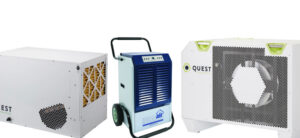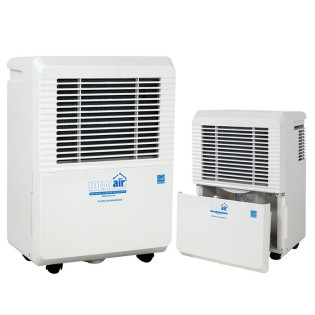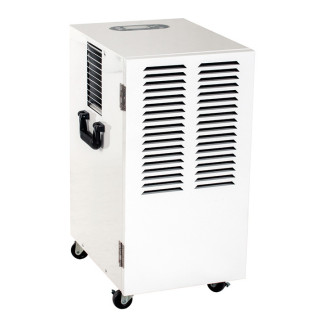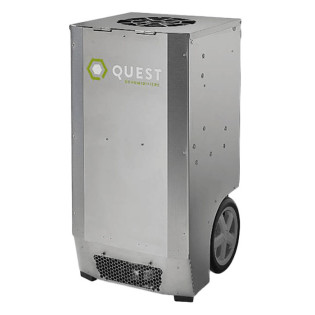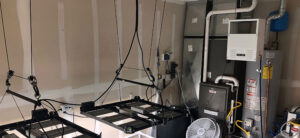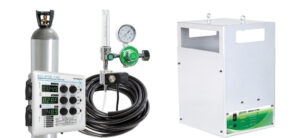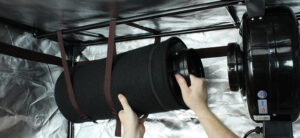
If you are looking for a dehumidifier calculator for your grow room, you are in the right place. We are going to help you size your dehumidifier for your grow room in this article.
One of the most commonly overlooked parts of setting up your indoor garden is accounting for the amount of moisture that will build up in your room from your plants transpiring.
Plants transpire about 97% of the water they receive, so the amount of water you remove from your room with a dehumidifier should be roughly equal to the amount of water you give to your plants each day.
Sizing your dehumidifier correctly from the start is very important to the success of your garden. Choosing an undersized dehumidifier will lead to mold, pest problems and powdery mildew among other serious issues.
What To Consider When Sizing Your Grow Room Dehumidifier
When trying to size your grow room dehumidifier, there are a few things to consider:
- Pints Per Day Removed
- BTU's Produced
Both of these should play a part in choosing the right unit for you.
Pints Per Day - The Biggest Factor
The number one factor in choosing a grow room dehumidifier is how many pints of water per day it can remove from your tent or facility.
We'll go more in depth on this in a minute, but we wanted to quickly define this parameter for you, because you will see it used a lot when shopping for a dehumidifier.
What Are BTU's, And How Do They Factor Into Sizing A Dehumidifier?
The second most important factor is determining whether your space can handle the BTU' produced by your dehumidifier.
BTU stands for British Thermal Units, and is a measure of heat energy put out by a piece of equipment.
If your unit produces too many BTU's for your grow room, you may be creating an unideal environment for your plants in the process.
What Size Dehumidifier Do I Need For My Grow Room?
To determine what size dehumidifier your room will need to do some basic calculations. First, how much water are you giving to your plants each day?
For example, if your garden has 20 plants and you are watering with 1 gallon per plant per day, you will have 20 gallons of moisture to remove from your room.
Since dehumidifiers are rated in pints you need to multiply the number of gallons you give to your plants each day by a factor of 8 to convert to pints, which for this example is 160 pints of moisture you will be needing to remove.
If you are growing in soil and you only water every other day you will need to divide the total pints by 2 to get the average per day.

Sizing Your Dehumidifier For Hydro Systems
If you are using a hydroponic system you simply need to follow the same equation as above taking into account the water capacity of your system and any reservoirs that do not have a lid. The only difference is you'll divide the figure you get by 7 (days in a week).
This is because your plants won't be consuming all the water in your reservoir, so sizing your dehu under the impression that they would is going to be overkill.
Because you'll be changing out or topping off your reservoir every 7-10 days, you'll have to do some division to get a more accurate sizing. Our team has found that the above equation results in a better fit for hydro systems.
We recommend covering all reservoirs to prevent contamination and any additional humidity being added to the room.

Factors To Consider Along With Your Dehumidifier
Are you running an air-conditioner? If you have a sealed room with an a/c, the a/c will remove some of the moisture itself.
Check your a/c to see how many pints per day it removes, and subtract that from your daily dehumidifying needs.
But, remember that your a/c will only be running occasionally. So when calculating size, make sure to play it safe and get a larger dehumidifier than you think you need. Under sizing is a common mistake newer growers tend to make.
If using CO2 in your room, it will increase the humidity levels. Also, if you are exhausting air from your room, the effectiveness of the dehumidifier will decrease. In either situation, consider increasing dehumidification performance.
Sizing a dehumidifier for a drying room
Before we explain how to calculate dehumidifier size for a drying room, understand that you won't want to use a standard unit here. Desiccant units do far better because they don't get as stressed by the extreme moisture content in the atmosphere.
If you are sizing a dehumidifier for your indoor drying room, you may be under the impression that finding a huge dehumidifier can speed up the drying process.
You're right, a dehumidifier will certainly dry out your buds fast. But this actually isn't what you want!
Dry Your Flower Low & Slow!
When it comes to drying your flower, low and slow is the mantra you should live by. Trying to dry out your buds as fast as possibe will suck the flavor, potency, and enjoyment from them.
But, if you have a decent-sized drying room, you may need some level of dehumidification. You need to know the wet weight going in to accurately calculate your dehumidification needs for your grow room.
If you bring in 100 pounds of wet flower, you can expect it to lose 80 pounds of water weight. That is because about 80% of your fresh flower is water weight, and will evaporate during the drying process.
Now, of that weight, you can safely assume that 60-70% of that water is going to be absorbed into the atmosphere in the first few days of drying. What this means for you, the grower, is you need to a dehumidifier capable of removing this much moisture in a few days.
As a rule of thumb, this will evaporate into about 7 gallons of water into the environment. To calculate dehumidification needs, you would just convert these 7 gallons to pints. This is 56 pints.
So, you can safely assume you need a dehumidifier rated at at least 60 pints a day.
All of this is assuming you're drying in the ideal conditions - which is 60 degrees Fahrenheit, 60 percent humidity. We recommend you check out our complete guide on drying and curing.
Want Recommendations On Which Unit Is Right For You?
We recently put together our list of the top grow room dehumidifiers of the year. We break it down based on grow room size and type, so you can narrow down the selection.
From small grow tent grows to huge, industrial indoor farms - we have a unit for everyone on this list. Check it out!
Final thoughts on sizing your grow room dehumidifier
Remember, sizing your dehumidifier is about how much water your room receives on average per day. Water in, water out is the most simple way to go about calculating your dehumidifier.
If you have additional questions or need help determining what dehumidifier will best fit your needs, don't hesitate to reach out. Our experts will help you size your unit if you are unsure, and can save you from getting too small or too large of a unit.
If you haven't already, we recommend you check out our complete guide to grow room atmosphere and ventilation. It will give you a better understanding of whether or not you need a dehumidifier in the first place.





